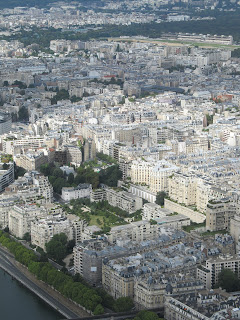While in Paris, we took a walking tour through part of the city. Of all the buildings we saw on the tour, Notre Dame de Paris was the most impressive. I had heard of this cathedral, of course, but I had no real knowledge of its history. Like many, I've watched Victor Hugo's
The Hunchback of Notre Dame (Disney style), but that was about it.
Well, I learned that there was never a hunchback, I learned that "Notre Dame" means "Our Lady" in French, and I learned that a guided tour of this building will tell you more than any old book. Work began on this cathedral in 1163 and was mostly completed by 1250. It is a great example of French Gothic architecture, sculpture and stained glass.
According to one site, Notre Dame is the most popular monument in Paris and in all of France, beating even the Eiffel Tower with 13 million visitors each year. (Since France is the most visited country in the world, I guess that says a lot about this building!) It's still an active Catholic church, a place of pilgrimage, and the focal point for Catholicism in France.
Here are some historical facts for those REALLY interested in Notre Dame:
- It stands on the site of Paris' first Christian church, Saint Etienne basilica, which was itself built on the site of a Roman temple to Jupiter.
- Notre Dame's first version was a "magnificent church" built by Childebert I, the king of the Franks at the time in 528. However, in 1160, having become "the parish church of the kings" of Europe, Bishop Maurice de Sully deemed the building unworthy of its lofty role and had it demolished.
- Construction on the current cathedral began in 1163, during the reign of Louis VII.
- During the reigns of Louis XIV and Louis XV at the end of the 17th century the cathedral underwent major alterations, during which many tombs and stained glass windows were destroyed.
- In 1793, the cathedral fell victim to the French Revolution. Many sculptures and treasures were destroyed or plundered.
- A restoration program was initiated in 1845. The restoration lasted 23 years, and included the construction of a spire.

While on the tour, our guide took us to the backside of the cathedral to show us the flying buttresses.
What I found most interesting, though, was an addition to the cathedral honoring Victor Hugo's story. The Hunchback of Notre Dame is now a PART of Notre Dame. This tiny figure would be overlooked by most, unless you knew to look for it. (We were the only ones looking at this part of the cathredral at the time of our tour, while the lines to get into the cathedral were long, long, long!) Our tour guide told us that this little figure of the hunchback is the only piece of the cathedral that serves no purpose, other than to honor Victor Hugo's beloved character.




























